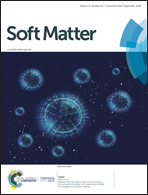Rolling friction of elastomers: role of strain softening†
Abstract
We study the temperature and velocity dependency of rolling friction. Steel and PMMA cylinders are rolled on sheets of nitrile butadiene rubber (NBR), with and without filler, and fluoroelastomer (FKM) with filler. Measurements of the rolling friction are performed for temperatures between −40 °C and 20 °C, and for velocities between 5 μm s−1 and 0.5 cm s−1. For the unfilled NBR, a smooth rolling friction master curve is obtained using the bulk viscoelastic frequency–temperature shift factor aT. For the filled rubber compounds, a small deviation from the bulk viscoelastic shift factor is observed at low temperatures. The experimental data are analyzed using an analytical theory of rolling friction. For the filled compounds, good agreement with theory is obtained when strain softening is included, which increases the rolling friction by a factor ∼2 for the filled FKM and ∼3 for the filled NBR compounds. For the unfilled NBR, the maximum of the rolling friction occurs at higher sliding speeds than predicted by the theory. We discuss the role of the adhesive (crack-opening) contribution to the rolling friction, and the role of frozen-in elastic deformations as the rubber is cooled down below the rubber glass transition temperature.



 Please wait while we load your content...
Please wait while we load your content...